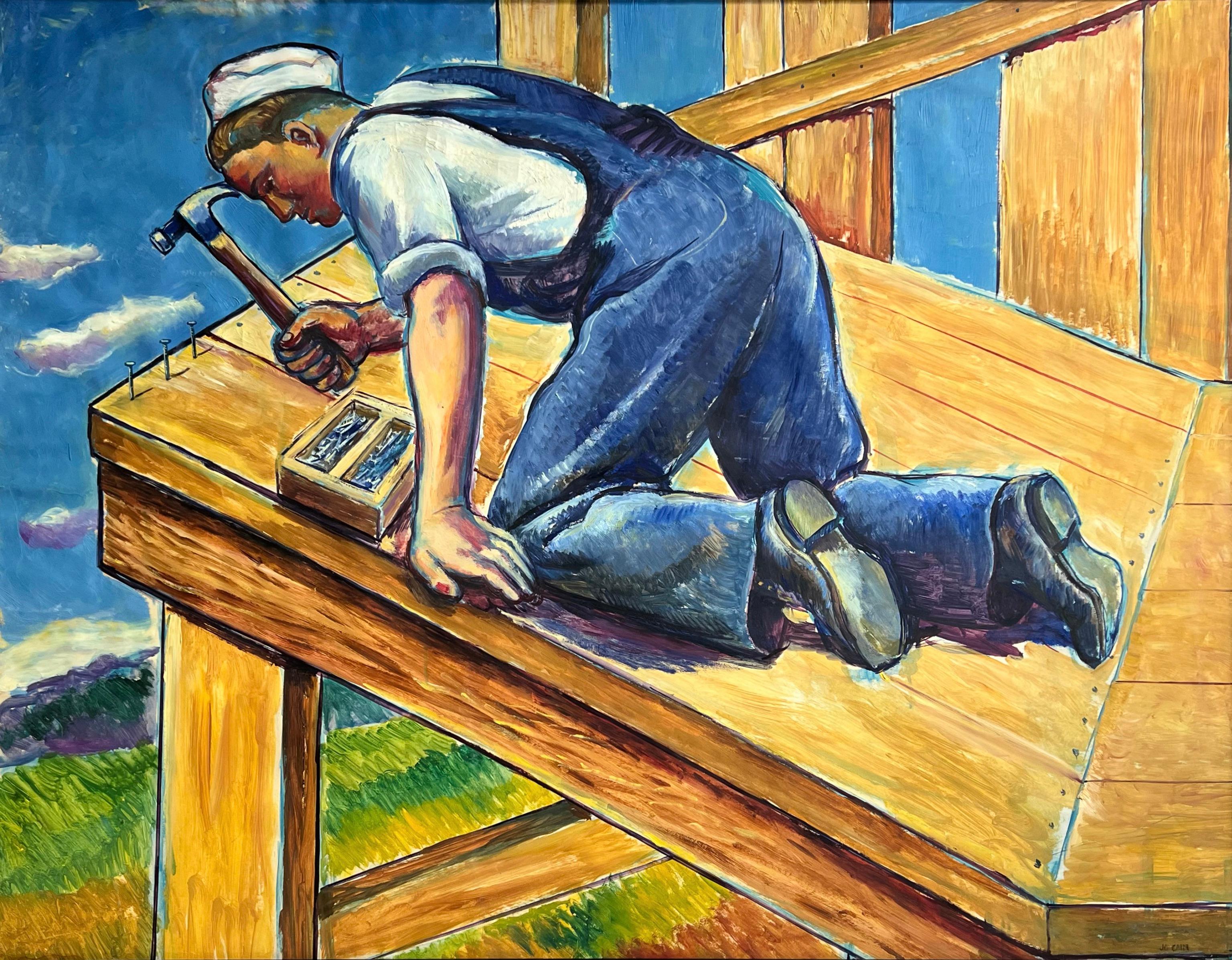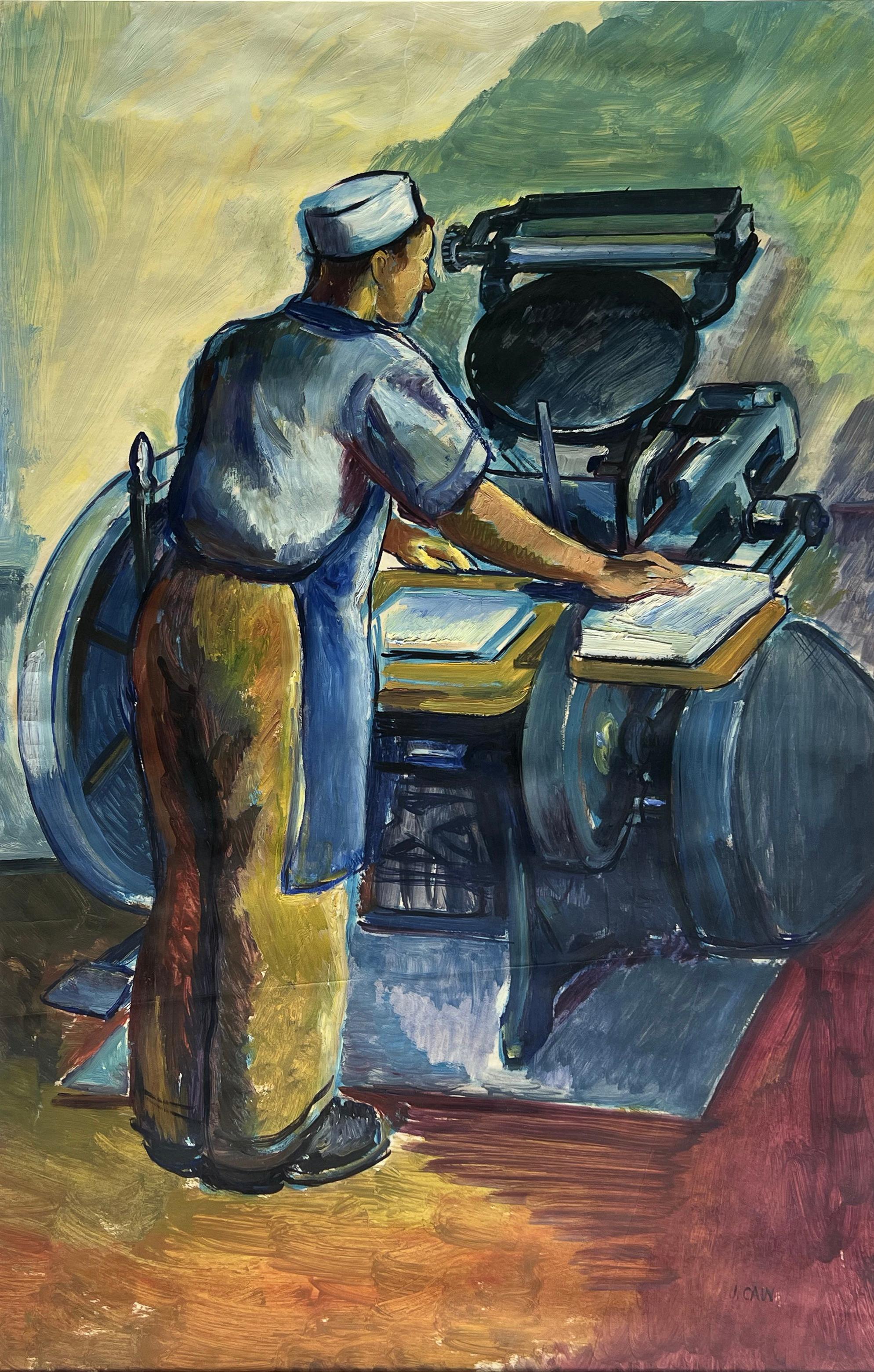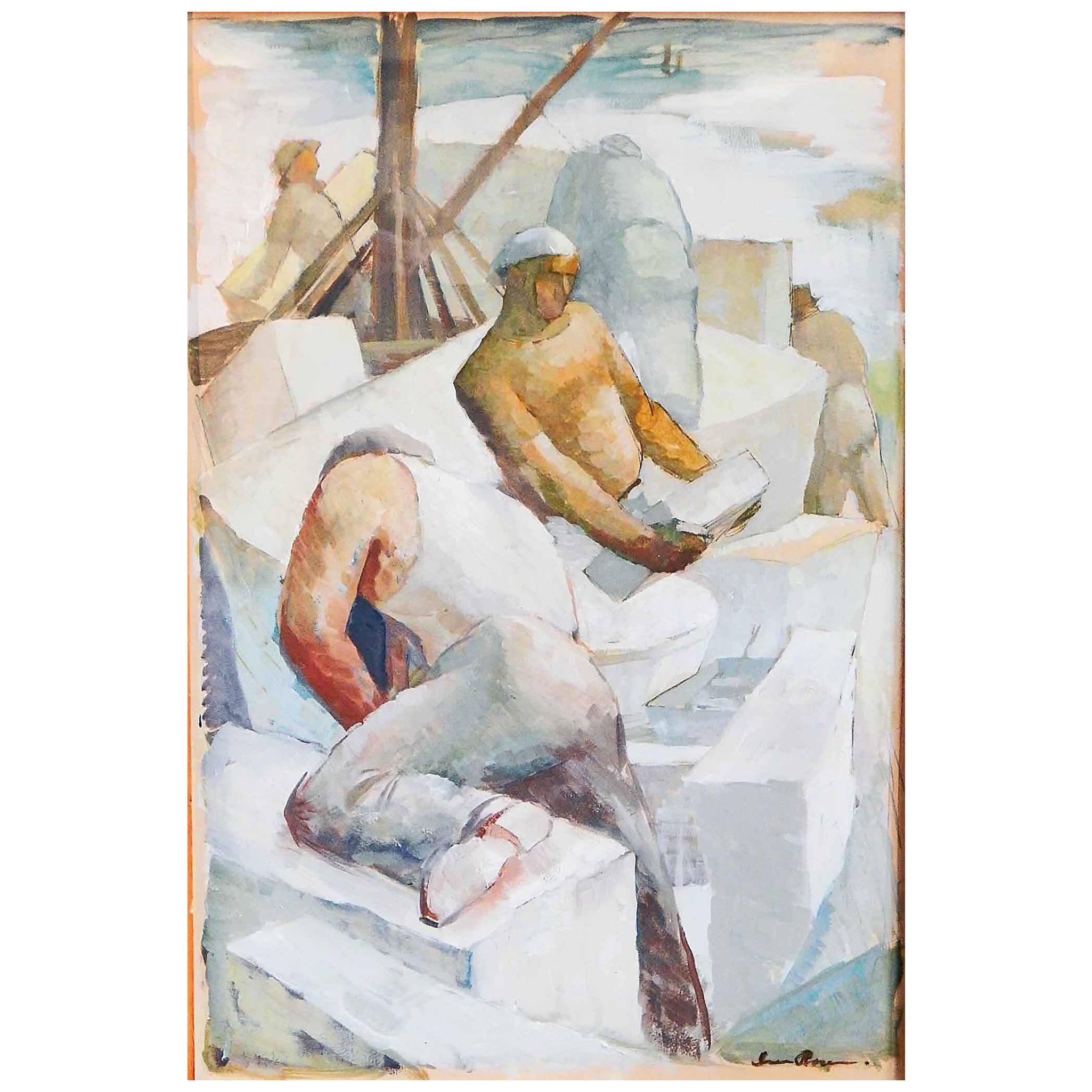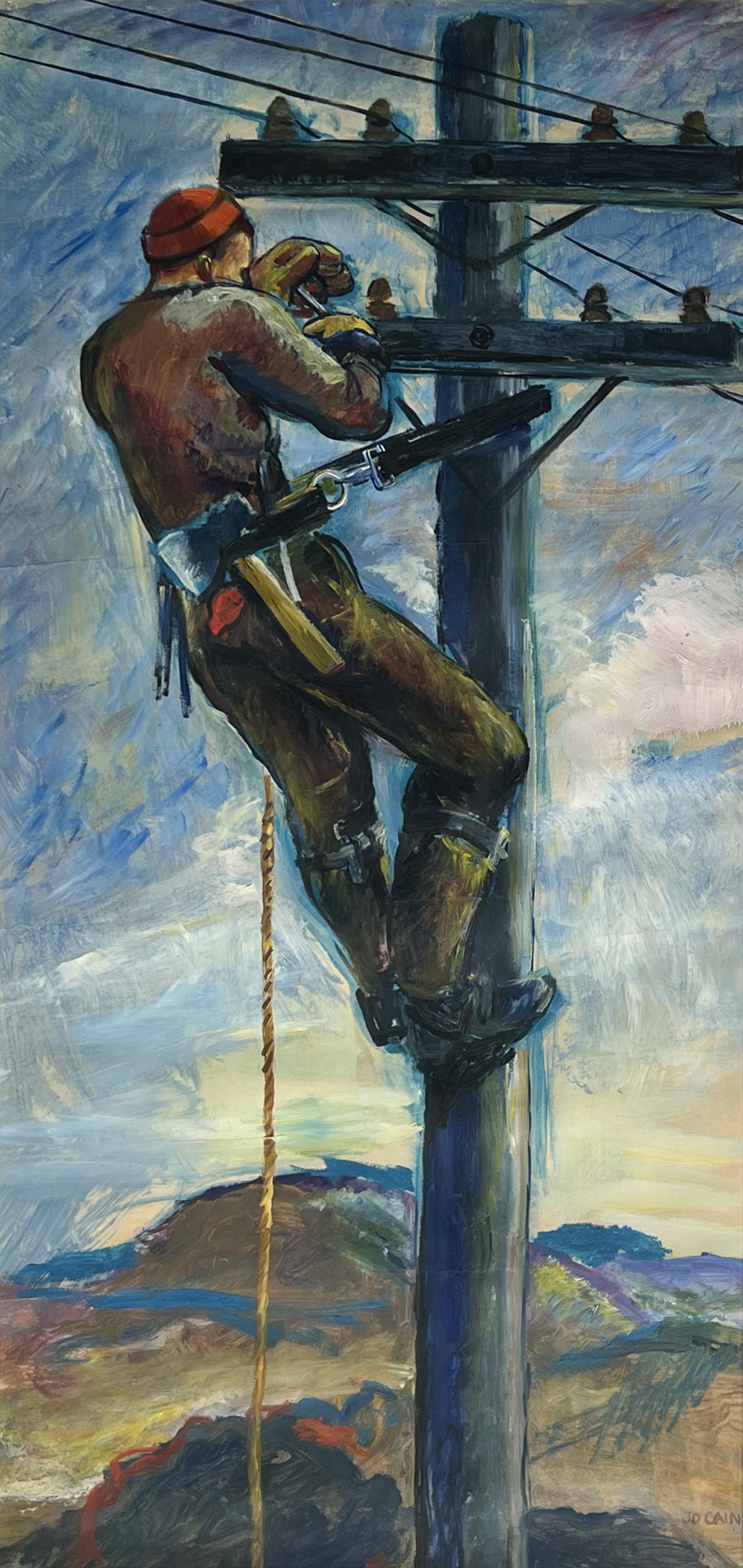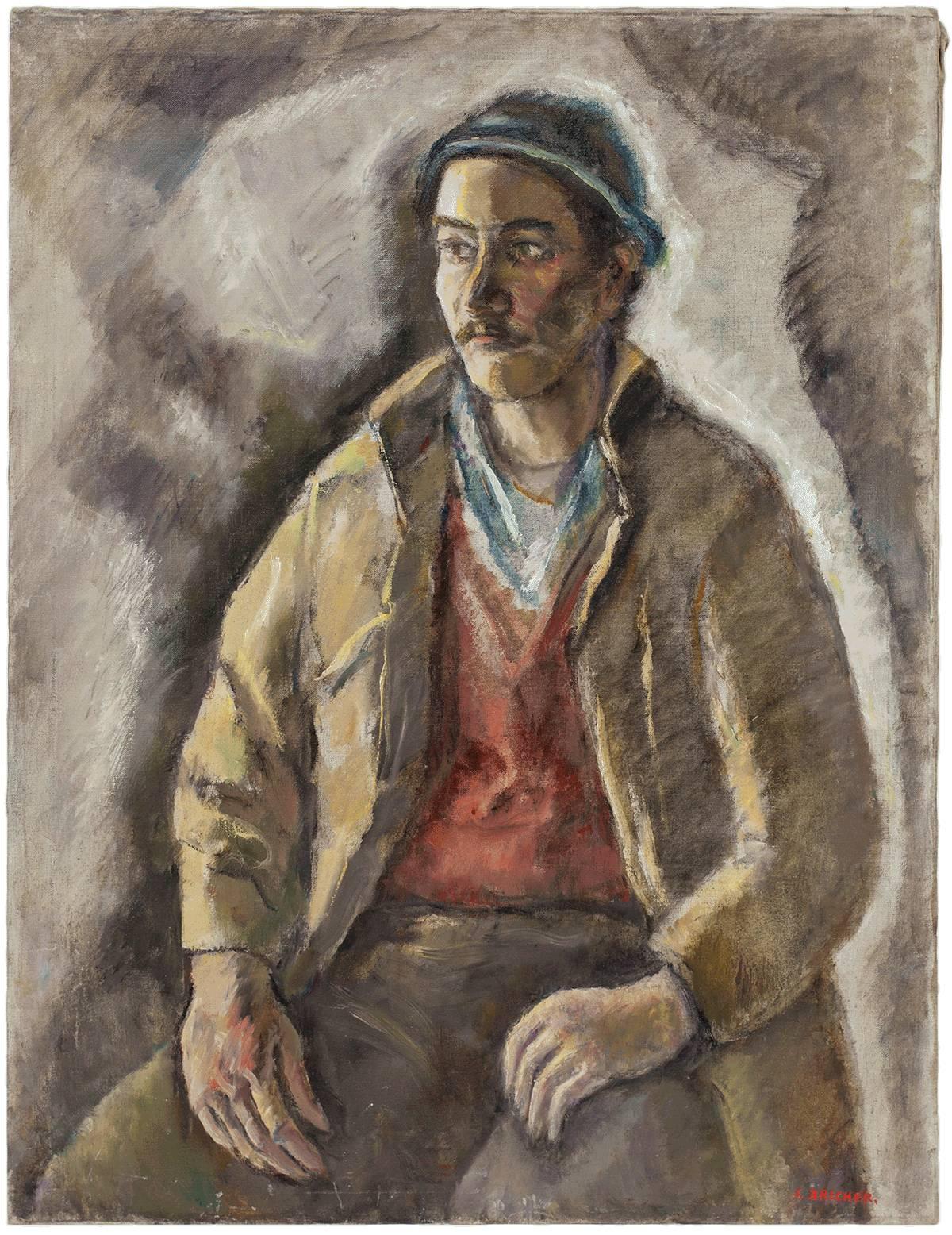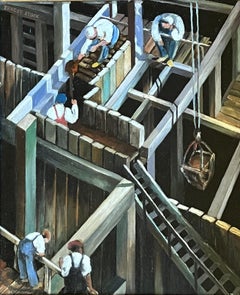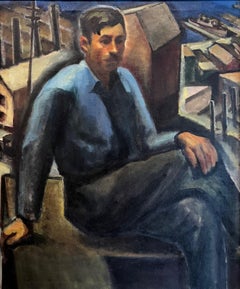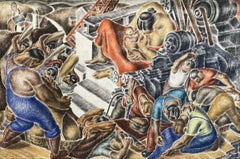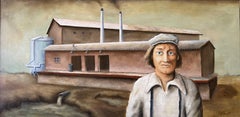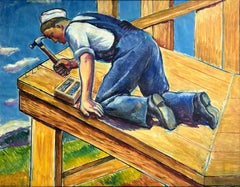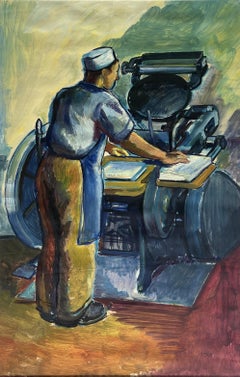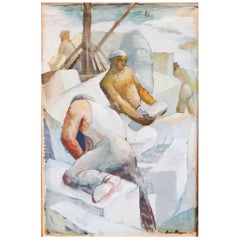Items Similar to Quarry Workers
Want more images or videos?
Request additional images or videos from the seller
1 of 5
Alexi ManyQuarry Workersc. 1930s
c. 1930s
$4,500
£3,488.37
€3,948.56
CA$6,440.46
A$7,027.98
CHF 3,647.93
MX$84,083.75
NOK 46,303.92
SEK 43,372.29
DKK 29,494.42
About the Item
This painting is part of our exhibition America Coast to Coast: Artists of the 1930s
Quarry Workers, c. 1930s, mixed media on board, unsigned, 24 x 24 inches, possibly exhibited at Many's Solo Exhibition at the Washington Art League, November 1934; provenance includes Many's sister; note: accompanied by letter of authenticity from Charles Gerhardt noting that the painting was acquired as part of a group of works from Many’s sister who lived in Lebanon, OH and that the group included three works on board in metal frames, none of which were signed, but all of which were ascribed to Many by his sister; presented in original painted metal frame
About the Painting
Alexis Many painted Quarry Workers in the early 1930s after a trip to Mexico which had a dramatic impact on his art. Before this trip, much of Many's work was bright, decorative, carefully rendered, and easy to digest. After his exposure to Mexican muralism and the challenges of the Great Depression south of the border, the overall look and feel of Many's paintings changed. Writing about Many's 1934 solo exhibition at the Washington Art League where Quarry Workers may have been shown, an art critic for the Evening Star wrote, "The current showing . . . represents, to a great extent, if not entirely, the fruits of travel and sojourn in Mexico and marks a considerable diversion on the part of the painter in the style and character of his work, which while always decorative and stylistic, was heretofore in higher key and much less grim. That it is, in the examples set forth, still decorative and very individualist none will deny, but discounting these virtues is a note of the primitive . . . Almost all the canvases in the collection are interesting in pattern and rather sonorous in color." In Quarry Workers, Many's figures have changed from a conservative, almost academic approach to a gritty form of modernism with spare detail, thick dark outlines and block-like forms, which mirror the surrounding stones and rock faces. Gone are the refined surfaces of his earlier paintings. In Quarry Workers texture dominates the square composition which Many seems to have favored after his Mexican sojourn. The artist must have been fond of his new creative approach since he often exhibited his Mexican works, including most of the twenty-one paintings at his solo show, a painting called Two Children at the 1932 Annual of the Nebraska Art Association and Church in the Rocks at the 46th Annual Exhibit of the Society of Washington Artists at the Corcoran Gallery, which Leila Mechlin, art critic and cofounder of the American Federation of Arts described as "a big and splendid conception which, while of today, is rooted in the depths of ancient tradition. At no time has Mr. Many produced a more impressive and notable work."
About the Artist
A native of Indiana, Alexis Many pursued his career as an artist and teacher mainly in Washington DC. Many trained in New York before arriving in Washington in 1901, where he was an art instructor at McKinley High School for almost four decades. Serving as a teacher, allowed Many to spent many summers in Laguna Beach, where he exhibited and won a prize at the California Art Club and traveled to Mexico. Many was a member of the Salmagundi Club, the Society of Washington Artists, the Laguna Art Association and the Washington Art League. He exhibited frequently at the Corcoran Gallery of Art in Washington DC, including having a solo show. Many was a fixture in the Washington art scene. Upon his death, C. Powell Minnegerode, Director of the Corcoran reflected, "Mr. Many was an able painter. His death is a loss to the Washington art brotherhood." He is listed in Who Was Who in American Art and other standard references.
- Creator:Alexi Many (1879 - 1937, American)
- Creation Year:c. 1930s
- Dimensions:Height: 24 in (60.96 cm)Width: 24 in (60.96 cm)Depth: 3 in (7.62 cm)
- More Editions & Sizes:24 x 24 Price: $4,500
- Medium:
- Movement & Style:
- Period:
- Condition:
- Gallery Location:Los Angeles, CA
- Reference Number:1stDibs: LU1859213055132
About the Seller
5.0
Gold Seller
Premium sellers maintaining a 4.3+ rating and 24-hour response times
1stDibs seller since 2022
17 sales on 1stDibs
- ShippingRetrieving quote...Shipping from: Los Angeles, CA
- Return Policy
More From This Seller
View AllSubway Construction
Located in Los Angeles, CA
This painting is part of our exhibition American Coast to Coast: Artists of the 1930s
Subway Construction, c. 1928, oil on board, 19 x 15 ¾ inches, signed upper left, artist and title verso; exhibited: 1) 12th Annual Exhibition of the Society of Independent Artists, The Waldorf Astoria, New York NY, from March 9 to April 1, 1928, no. 864 (original price $250) (see Death Prevailing Theme of Artists in Weird Exhibits, The Gazette (Montreal, Quebec, Canada), March 8, 1928); 2) Boston Tercentenary Exhibition Fine Arts and Crafts Exhibition, Horticultural Hall, Boston MA, July, 1930, no. 108 (honorable mention - noted verso); 3) 38th Annual Exhibition of American Art, Cincinnati Art Museum, Cincinnati, OH, June, 1931 (see Alexander, Mary, The Week in Art Circles, The Cincinnati Enquirer, June 7, 1931); and 4) National Art Week Exhibition [Group Show], Montross Gallery, New York, New York, December, 1940 (see Devree, Howard, Brief Comment on Some Recently Opened Exhibitions in the Galleries, The New York Times, December 1, 1940)
About the Painting
Ernest Stock’s Subway Construction depicts the excavation of New York’s 8th Avenue line, which was the first completed section of the city-operated Independent Subway System (IND). The groundbreaking ceremony was in 1925, but the line did not open until 1932, placing Stock’s painting in the middle of the construction effort. The 8th Avenue line was primarily constructed using the “cut and cover” method in which the streets above the line were dug up, infrastructure was built from the surface level down, the resulting holes were filled, and the streets reconstructed. While many artists of the 1920s were fascinated with the upward thrust of New York’s exploding skyline as architects and developers sought to erect ever higher buildings, Stock turned his attention to the engineering marvels which were taking place below ground. In Subway Construction, Stock depicts workers removing the earth beneath the street and building scaffolding and other support structures to allow concrete to be poured. Light and shadow fall across the x-shaped grid pattern formed by the wooden beams and planks. It is no surprise that critics reviewing the painting commented on Stock’s use of an “interesting pattern” to form a painting that is “clever and well designed.”
About the Artist
Ernest Richard Stock was an award-winning painter, print maker, muralist, and commercial artist. He was born in Bristol, England and was educated at the prestigious Bristol Grammar School. During World War I, Stock joined the British Royal Air Flying Corps in Canada and served in France as a pilot where he was wounded. After the war, he immigrated to the United States and joined the firm of Mack, Jenny, and Tyler, where he further honed his architectural and decorative painting skills. During the 1920s, Stock often traveled back and forth between the US and Europe. He was twice married, including to the American author, Katherine Anne Porter. Starting in the mid-1920s, Stock began to exhibit his artwork professionally, including at London’s Beaux Arts Gallery, the Society of Independent Artists, the Salons of America, the Cincinnati Art Museum, the Whitney Studio and various locations in the Northeast. Critics often praised the strong design sensibility in Stock’s paintings. Stock was a commercial illustrator for a handful of published books and during World War II, he worked in the Stratford Connecticut...
Category
1920s American Modern Figurative Paintings
Materials
Oil
A Laborer Resting
By Robert Gilbert
Located in Los Angeles, CA
A Laborer Resting, 1930, oil on canvas, signed and dated lower center, 36 x 30 inches, inscribed verso “July – 1930 / Title – A Laborer Resting / Artist – Robert Gilbert / Price - $2...
Category
1930s American Modern Figurative Paintings
Materials
Canvas, Oil
Farm Tragedy (Untitled)
Located in Los Angeles, CA
Farm Tragedy (Untitled), c. 1930s, mixed media on plaster on panel, unsigned, 22 1/8 x 32 inches; label verso reads: "New York Artists Equity Association, New York, NY," provenance i...
Category
1930s American Modern Figurative Paintings
Materials
Mixed Media
Factory Worker
Located in Los Angeles, CA
This painting is part of our exhibition America Coast to Coast: Artists of the 1930s
Factory Worker, c. 1936, oil on canvas, signed lower right, 18 ¼ x 36 inches; exhibited in City ...
Category
1930s American Realist Figurative Paintings
Materials
Oil
Blacksmith (Untitled)
By Erle Loran
Located in Los Angeles, CA
Blacksmith (Untitled), 1936, oil on canvas, signed and dated lower right, 28 x 30 inches
Erle Loran was an influential American painter, art historian, and educator, renowned for h...
Category
1930s American Modern Figurative Paintings
Materials
Canvas, Oil
Street Cleaners
Located in Los Angeles, CA
This painting is part of our exhibition America Coast to Coast: Artists of the 1930s
Street Cleaners, c. 1940s, oil on canvas, signed lower right, 28 ¾ x 42 inches, Gallery Z...
Category
1940s American Modern Figurative Paintings
Materials
Oil
You May Also Like
Industrial Man Working Mid 20th Century American Scene Social Realism Modern WPA
By Jo Cain
Located in New York, NY
Industrial Man Working Mid 20th Century American Scene Social Realism Modern WPA
Jo Cain (1904 - 2003)
Hammering Nails
39 x 50 ½ inches
Gouache on paper c. 19...
Category
1930s American Realist Figurative Drawings and Watercolors
Materials
Paper, Gouache
Working Man WPA Social Realism Industrial Modernism 20th Century American Scene
By Jo Cain
Located in New York, NY
Working Man WPA Social Realism Industrial Modernism 20th Century American Scene
Jo Cain (1904 - 2003)
Printing Press
40 ½ x 26 inches (sight)
Oil o...
Category
1930s American Realist Figurative Drawings and Watercolors
Materials
Paper, Oil
"Quarry Men, " Striking Art Deco-WPA Depiction of 1930s Laborers, Rockport
By Iver Rose
Located in Philadelphia, PA
The painter Iver Rose is best known for his work which brought attention to the plight of workers in Depression Era America. This painting of quarry workers in Rockport, Massachusett...
Category
Vintage 1930s American Art Deco Paintings
Materials
Paint
"Working Laborers, " Francis Bevilacqua, Soviet Cold War Art
Located in New York, NY
Francis Bevilacqua (American, b. 1911)
Working Laborers, n.d.
Oil and pigment on black granite
44 x 21 inches
Signed lower right
Born in 1911, Francis Bevilacqua was predominantly influenced by the 1930s. The period of the 1930s is epitomized by the conflict between many political ideologies, including Marxist Socialism, Capitalist Democracy, and the Totalitarianism of both Communism and Fascism. In the Soviet Union, Stalin’s government needed urgent funds to implement the rapid industrialization demanded by the first Five Year Plan. It initiated a secret strategy to sell off treasures from the State Hermitage Museum in Leningrad (St. Petersburg), including a primary list of two hundred and fifty irreplaceable paintings by the Old Masters, a number of which ended up in the collection of Andrew Mellon...
Category
Mid-20th Century Realist Figurative Paintings
Materials
Granite
Man Working Mid 20th Century American Scene Social Realism Industrial WPA Modern
By Jo Cain
Located in New York, NY
Man Working Mid 20th Century American Scene Social Realism Industrial WPA Modern
Jo Cain (1904 - 2003)
Telephone Pole Worker
38 1/4 x 18 1/2 inches
Oil on pap...
Category
1930s American Realist Figurative Drawings and Watercolors
Materials
Paper, Gouache
Portrait of Working Class Man
By Samuel Brecher
Located in Surfside, FL
American artist Samuel Brecher (active NY, 1897-1982) Oil on Canvas, Signed lower right ‘S. Brecher’
Brecher was a very accomplished painter who won over forty prestigious prizes and awards during his career, and had numerous one-man exhibitions. Brecher’s works are included in many important private collections as well as the Metropolitan Museum of Art, the Walker Art Museum, the Smithsonian and the Newark Museum of Art. He is listed in Who’s Who in American Art and is a member of the Salmugundi Club* and the National Academy of Art
Samuel Brecher was born in Boryslaw, Austria, a town near the Carpathian Mountains, now a part of Poland. His family came to New York in 1910, where Samuel graduated from Cooper Union* in 1921. He studied Art at the National Academy of Design* from 1921-1924, and continued studies under Charles W. Hawthorne in Provincetown, Massachusetts.
Brecher was represented by several well known New York City galleries in the 1940’s and 1950’s including the Kraushaar Gallery, the ACA Gallery, the Hudson Walker Gallery and the Merrill Gallery. During his career he won over forty prestigious prizes and awards and had numerous one-man shows.
Some of Brechers’s contemporary artist friends were Walt Kuhn, Reginald Marsh, Richard Haley...
Category
Mid-20th Century Modern Portrait Paintings
Materials
Canvas, Oil
More Ways To Browse
Vintage Worker
Vintage Stone Mirror
Cafe Scene Painting
Charlie Chaplin Vintage
Blue Face Painting
Isaac Pelayo
Kibbutz Art
New Yorker Cover
Opera Singer
Picasso Oil Painting
Shaw London
Vintage Circus Performers
Dior 1955
Golden Age Of Illustration
Jazz Oil Painting
Old Master Christ
Shadow Puppets
Social Realism Social Realism Art 1930s And 1940s
